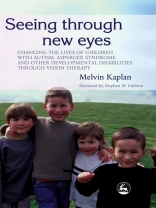Seeing Through New Eyes offers an accessible introduction to the treatment of visual dysfunction, a significant but neglected problem associated with autism spectrum disorders (ASDs) and other developmental disabilities.
Dr. Kaplan identifies common ASD symptoms such as hand-flapping, poor eye contact and tantrums as typical responses to the confusion caused by vision disorder. He also explains the effects of difficulties that people with autism experience with ‚ambient vision‘, including a lack of spatial awareness and trouble with coordination. Other chapters give guidance on how to identify the visual deficits of nonverbal children, select prism lenses that will alter the visual field, and create individually tailored programs of therapy in order to retrain the system.
This book is essential reading for parents of children with ASDs, and professionals in the fields of autism, optometry and ophthalmology, psychology and education.
Inhaltsverzeichnis
Foreword, Stephen Edelson, Autism Research Institute, San Diego Part I: Understanding Visual Dysfunction and the Role of Prism Lenses and Vision Therapy. 1. The Behavior is the Solution. 2. Prism Lenses and Vision Therapy: Overview and Historical Perspective. Part II: The Kaplan Nonverbal Battery: Testing and Interpretation of Results. 3. Special Tests for Special Needs. 4. Analyzing your Test Results: The Art and Science of Knowing your Patient. Part III: Planning a Visual Management Program. 5. The Therapy Process: A Philosophical Overview. 6. Therapy Approaches for Patients with Strabismus. 7. Therapy Approaches for Patients with Orientation Issues. 8. Therapy Approaches for Patients with Spatial Organization Issues. 9. What does Breathing have to do with Vision? 10. The Big Picture: Integrating Vision Therapy into a Comprehensive Treatment Program. Glossary. Index
Über den Autor
Melvin Kaplan OD is Director of the Center for Visual Management in New York. He is a qualified Doctor of Optometry, and has previously worked as a clinical instructor of behavioral sciences at New York Medical College. He has published a significant body of research on ambient lenses and their role in the rehabilitation of individuals who display dysfunction in learning or emotion, and those with autistic spectrum disorders.












